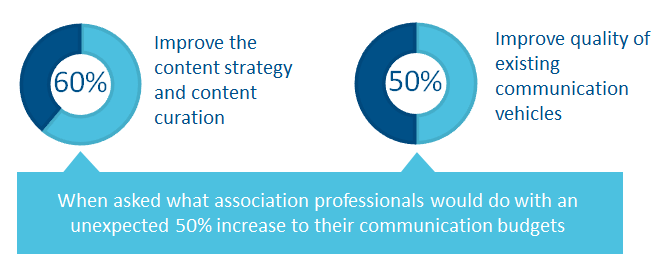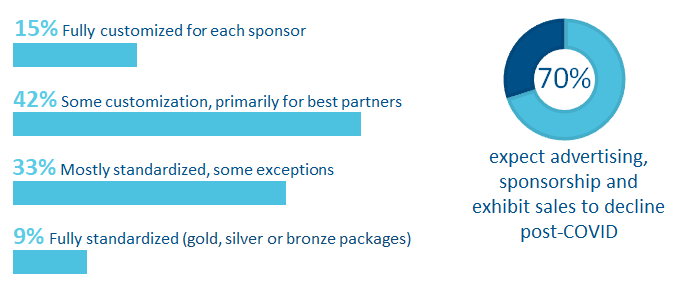How to Move Communications Forward in the COVID Era
Associations have long known that one of the biggest challenges they face is how to rise above the noise and communications clutter to get their message out to members. Never has that that been more true or have the stakes been as high as during the COVID-19 pandemic and recovery.
Nearly six months since the coronavirus brought some industries to a halt and emphasized the importance of others as essential to our professional and personal well-being, associations have been on the forefront of information gathering and dissemination for how to shift to a remote workforce, keep employees and the public safe and healthy, and support businesses in the face of a struggling economy.
This year’s Association Communications Benchmarking Survey and Report includes questions for association professionals about how COVID-19 has impacted their communications strategy, while also tracking progress in a number of key areas surveyed every year. Here are five recommendations based on the report’s finding that will help associations best move forward in our quickly changing communications landscape.
-
Embrace new and innovative ways to engage.
Being open to change and embracing innovation isn’t a new concept for leaders today, but it is one that has an added level of urgency in the wake of the COVID-19 pandemic. From helping members adapt to remote work or fight the pandemic on the front lines to planning virtual conferences where companies can continue to do business in an uncertain economy, associations have had to test out new concepts, ideas and even technologies at a faster pace than ever before.

COVID-19 has created an atmosphere that is prime for courageous decision-making. While this year’s report shows the majority of associations (80%) are struggling with how to transform their live events into virtual ones, there’s a great opportunity for those associations willing to take risks and experiment. Accept the fact that mass gatherings and face-to-face events may not be feasible in many parts of the country for at least the near future; instead, use virtual events as a way to test new session topics, speakers, and delivery platforms for potential live events down the road.
Social media is another area where your association can step out of your comfort zone and try a new approach. As members find themselves online more than before because of continued social distancing, social media can be a way to keep members engaged and connected – both to your association and each other. At the same time, if your association has ever considered starting a podcast, now may be the time to take that leap. Podcasts, which your members can listen to when and where fits it best fits into their schedule, saw a 12% increase in perceived value in this year’s report.
While all this talk about new technologies and innovative decision-making can be exciting, it’s also tempting to succumb to “shiny object syndrome.” Keep in mind that just because something is new doesn’t mean it’s necessarily better or the right fit for your association. That’s why it’s important to keep your long-standing communication channels a part of overall strategic conversation. Print is still highly valued – member magazines were the third highest ranked communication channel in this year’s report – as it allows for long-form analysis and critical thought leadership that you just can’t obtain with some digital channels. An integrated, balanced approach to your traditional and trending communication platforms centered on your members’ wants and needs is always your best bet.
-
Provide exceptional value with your content.
We’ve said it before, and it’s worth repeating: It’s not just about creating content, it’s about creating relevant content for your members and your larger industry audience. Your communications team can create content all day long, but if it doesn’t speak to the issues and topics your members are talking about each and every day, it’ll largely go unseen or unread. More than half of our survey respondents this year said they must do a better job of understanding why certain content “resonates with members,” but how do you do that?
While it’s tempting to lump members into age groups, industry specialties and other common demographic profiles – and that’s certainly a good place to start if you’re not customizing content at all – keep in mind that no two members are exactly alike. For instance, a new member who is fresh out of college will have different needs from a new member who is in their 40s and undergoing an unexpected career change. They likely won’t be interested in the same content from you even though they’re both considered “new” members. Because of that, it’s important to get to know your members more closely and what topics resonate with them most: Health and safety, diversity and inclusion, advocacy on the federal, state and local levels, as well as how your specific industry are all top of mind right now.
Find new ways to tell the story, and even repurpose the same story in different formats for different audiences. Your video and audio becomes a podcast series, which you can turn into written member profiles, columns and features in print. Infographics and photo stories on social media are visually compelling and get your audience to click through online. This type of enhanced, comprehensive content strategy is what 60% of survey respondents said they’d focus on if they had an unexpected increase to their communication budget.

But it doesn’t always take a big budget to make things happen. Repurposing content into different formats for different channels is an efficient way to reach members. That’s a much easier goal to accomplish if you have a strategy that integrates all your communications and a plan for how you’ll create and manage your content. An annual plan guides your association’s time and resources; however, know that things may go off book. (COVID-19 is certainly an example of how that can and likely will happen.) That doesn’t mean you scrap the plan entirely, but focus on how to update your content throughout the year to reflect changes as they happen that build on your already strong foundation.
-
Make data-driven decisions.
Whether you’re wrestling with a challenge or weighing a potential opportunity, make sure you get data points from multiple sources before making big decisions. Don’t rely solely on qualitative responses or feedback. It can be tempting to do so, but your small yet most vocal group of members may not represent the whole. Instead, rely on the data your association has available to make informed decisions.
More than half of respondents this year told us they know they must do a better job of “understanding member needs, demographics and goals.” Use event attendee data, webinar registration, website analytics, newsletter readership statistics and social media engagement for clues about what members, along with advertisers and sponsors, are most interested in, including the content that resonates most with groups within your overall audience. Follow up with members to probe further into what the data is telling you about their needs and wants. Which education offerings, volunteer opportunities, networking opportunities, free and for-purchase resources, and career and job postings are most likely to keep them engaged with your association? Find out what they’re seeking and how you can better deliver.

-
Don’t take your advertisers, sponsors and exhibitors for granted.
Everyone is struggling right now and the benchmarking report confirmed what we suspected in the wake of COVID: Many associations are struggling with their sponsorships and exhibit sales and their non-dues revenue overall. Nearly three in four expect difficulty maintaining pre-COVID levels of advertising, sponsorships and exhibit sales. More than half of respondents said they recognize they have a serious or significant problem with the lack of revenue generated from their communication vehicles – up 10 percentage points higher than 2019. Since last year, only 26% of respondents say non-dues revenue has improved for their associations. All of these numbers make it clear that now is the time to do everything you can to keep your valued partners – and put in the effort to gain new ones.

With increasing pressure to keep membership dues in check, non-dues revenue has never been more important to the sustainability of membership organizations. Associations are an important voice in your industry or profession, but you are not the only place that your industry’s vendors and suppliers can go to get their products and services in front of key decision-makers. Every contract you sign and every dollar you receive comes with the understanding that you’ll demonstrate tangible return on investment for your advertisers and sponsors. Don’t wait for them to try to calculate their ROI for dollars spent with you – prove it to them first.
Unfortunately, one in four associations told us they still believe in the adage that “no news is good news” or that they don’t feel they have a “close enough relationship” with sponsors to ask. Bottom line: If you’re afraid to ask sponsors if they’re happy, then someone else will.
-
Focus on what you do best, and outsource the rest.
Association professionals have long prided themselves on their ability to wear multiple hats. In fact, the opportunity to have a wide variety of career experiences is what attracts many to the association profession in the first place. However, with 43% of associations who responded to this year’s survey telling us they feel chronically understaffed, you need to be highly selective about how you spend your time and budget each day.

Many associations today outsource some aspect of their communications program and rely on partners to help them accomplish their goals: Nearly two in four outsource production and design, more than one-third outsource advertising and sponsorship sales, and nearly one in four outsource their magazines. Be brutally honest with yourself and your team about what you do best. If you’re not highly competent or feel there are areas where bringing in an expert could take your communications to the next level, there are many excellent vendors and consultants who can not only provide these functions but be a valued extension of your staff. By outsourcing these critical functions, you and your team will have more bandwidth to focus on what you do best. By doing so, your members and your bottom line will be much better served.


